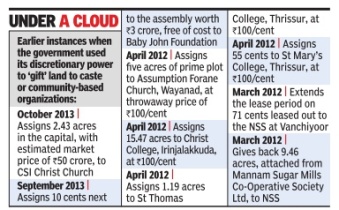The Kerala model of development has purposely neglected to include the Hindu community in its plans as it drives the agenda of hegemonic entities.
Kerala Model – Not an inclusive growth model

Left-wing economists have often tried to sell the Kerala model of development as a unique one centred around their ideology. According to the leftist narrative, Christian missionaries did the groundwork by introducing a refined educational system which paved the way for social reforms in the 19th century and subsequently provided fertile ground for introducing Marxian economics. They argue that this created the base for the Kerala model of development which led to significant improvements in material living conditions, on par with developed countries of Western Europe. They deliberately neglected any actual research and writing on the pre-colonial history of Kerala. It seems, their attempt was to uphold the Marxist tradition of rewriting history so that they could erase the past and propagate theories to help their imperialist interests. An independent analysis of history will show that matrilineal Kerala was always an egalitarian centre of learning blessed with natural resources — though there may have been weak spots- even before the Missionaries or Marxism set foot on its soil. They don’t want us to remember or acknowledge the contributions of the State in the field of mathematics, astronomy, philosophy etc. Tunchathu Ramanujan Ezhuthachan, the father of Malayalam language was an OBC. The Malayalam Ramayana written by him is still recited in all Hindu temples and households. Medicine and education were not restricted to any particular caste in Kerala. Hence, we see Ayurveda experts from all communities, Brahmin to Adivasi.
If there is anything that can be categorically said about the Kerala model of development after all these decades, it’s that it has failed to be inclusive. Studies after studies confirm that the fruits of development have not been equally distributed among the various religious communities. The development programmes focused mainly on social development. Communists ensured forcible stunting of capitalist growth, by opposing and mobilising people against it through its violent trade union activities and scuttled agricultural growth by opposing mechanisation. By the 90s, this economic stagnation compelled the youth to migrate in search of employment with a subsequent pouring in of remittances. Migration to the Arabian Gulf countries benefited Muslims who were the pioneers among those who left.
From 1967 onwards, Kerala has been ruled alternatively by 2 coalitions sharing a similar vision. However, they only focused on creating minority vote banks which used their influence to extract benefits for their followers. The organised minorities could pry out maximum privileges whereas the divided Hindus could only maintain the status quo.

The Land Reforms Act and the education imparted are mainly considered as the factors which laid the foundation of the Kerala model of development. The idea of state financing of school education paved the way for the subsequent injustice. Salaries of all staff and maintenance of the schools and colleges, whether state-owned or private, being paid for by the state. Whereas the Right to Property and appointment of the staff in aided institutions was retained by the management. Moreover, now there is a colossal disparity in the distribution of schools among various religious communities. The biggest share of the government-aided institutions is possessed by the Christian community. A vast area of land and infrastructure comes under the Christian community although the Government bears the expense for its maintenance. A Hindu student in a Christian institution is forced to learn moral science, which invokes anti-Hindu sentiments in him. The government essentially pays for an organised coup to gain more employment and influence in society by a particular community.

The targeted beneficiaries of the Land Reforms Act were the scheduled caste Hindu population. Though they became owners of small strips of land, it left them ghettoised. Since most of them were agricultural labourers, diminishing agriculture left them jobless. They thus became easy targets for Maoists, Christian missionaries and gangsters.
Keralites depend more on private health care facilities, making the state the highest spender in the health care sector in India. In 2004- 05, Kerala spent approximately Rs.2663 per capita for private health care services. Surprisingly, public health spending per capita in Kerala was just Rs 280. The acclaimed Kerala model has also failed to prevent monsoon fevers from visiting the state annually. The women’s high showing in socio-demographic indices is contradicted by their low public participation and the increasing incidence of violence against them. Though Kerala is a matrilineal society, women hold only about 15% of the jobs.
.png)
Demographic changes have only aggravated this situation. Out of the 14 districts of Kerala, Hindus are a minority in at least five districts. The fertility of Muslims continues to be higher despite education and economic empowerment. According to the NFHS (National Family Health Survey), survey II of 1998–99, in Kerala where the literacy level of Hindu and Muslim communities is almost equal (Muslims are economically well-off due to large Gulf remittance), the population growth rate of Muslims is 45% higher than Hindus. Only Hindus accepted the government’s social development programmes whole-heartedly as vigorous family planning campaigns resulted in reducing the population growth rate within the Hindu community. On the contrary, Muslims deliberately stayed away from adopting birth control measures and procreated as often as they could. Of late, Christians too embraced the strategic idea of producing more children to ensure an upper hand in the socio-economic system of the state.
What is the effect of this demographic shift?
Even though the two coalitions have been ruling the state alternatively, a group of privileged Christians and Muslims play a dominant role in controlling the economy, education, agriculture, banking, social policy, and the government policy formation in Kerala. Be it access to policy formulations or appointments in government corporations, Universities or Public Sector Enterprises, the Christian church and Muslim community has its say in shaping the government decision-making process. When 4 Legislative Assembly constituencies were added to the northern Muslim dominated districts, 2 constituencies were cut-off from the Hindu dominant southern districts. The mass media in Kerala also works in coherence with the financially strong and politically organised Christian and Muslim communities. Under the influence of the Marxist perspective, they endorsed the deceptive art of denial, hypocrisy, double standard, and rationalisation towards the majority community.
Subjugated by exclusive, aggressively organised, materialistic ideologies of Christianity, Islam and Marxism, the majority Hindu community has been cast away from the Kerala model of development.

Leave a Reply